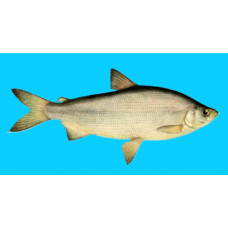Latin name
Coregonus peled
Other name
Northern whitefish
Identification
The peled can be easily distinguished from other whitefish by its terminal mouth, in which the upper jaw is only slightly longer than the lower jaw, and by its large number of gill rakers (49–68). Its body is tall and compressed from the sides.
Features of fish fins
As with all whitefish breeds, there is an adipose fin located between the dorsal and caudal fins.
Fish colouring
The peled coloration is silvery, with a dark gray back that is darker than that of other whitefish. It has small black dots on its head and dorsal fin.
Distribution
It inhabits the lakes and rivers of northern Eurasia, ranging from the Mezen River in the west to the Kolyma River in the east. Lake and river fish can enter the deltas of the rivers flowing into the Arctic Ocean east of Mezen.
Habitat
It is a polar marine and freshwater bottom-dwelling species that prefers brackish waters. Its depth range is 5-11 meters.
There are three forms of this species: the relatively fast-growing river form, which inhabits rivers and poma lakes and matures in its third year; the common lake form, which never leaves the lake where it was born; and the dwarf lake form, which has stunted growth and inhabits shallow, food-poor lakes. The dwarf lake form rarely exceeds five hundred grams; it is usually much smaller.
Size
The pelican's size ranges from 40 to 55 cm, and it weighs between 2.5 and 3 kg, though it can weigh up to 4 or 5 kg more rarely. Its life cycle is usually limited to eight to eleven years.
Behavior
It does not go to sea and is only occasionally caught in the slightly salty waters of Kara Bay. It can be considered a freshwater fish. It avoids flowing waters and concentrates in poma lakes, estuaries, and channels. In the spring, when the water level rises, the juvenile and adult fish disperse to feed in the floodplain bodies of water, such as lakes and inundations of the lower reaches and estuaries. As the water recedes, the fish move into channels and rivers.
Food and feeding habits
This species of fish is a planktophage. It feeds on zooplankton, bottom-dwelling animals (especially insect larvae, mussels, and algae), and insects from the surface.
Reproduction
The peled spawns in lakes. They spawn in the fall during the ice-out period from September to December in lakes and rivers with pebble grounds where keys emerge. Its fecundity is 5,000 to 8,500 eggs, each up to one and a half millimeters in diameter. The development period from fry to adult is 6-7 months.
Fishing
It is commercially important and is also artificially bred.
Relationship with a person
Potential pest. It is an ideal target for acclimatization in small ponds used for fish farming.
| Classification | |
| Phylum | Chordata |
| Class | Actinopterygii |
| Squad | Salmoniformes |
| Family | Salmonidae |
| Genus | Coregonus |
| Species | C. peled |
| Features | |
| Conservation status | Least Concern |
| Habitat | Bottom |
| Life span, years | 11 |
| Maximum body weight, kg | 5 |
| Maximum length, cm | 55 |
| Sailing speed, m/s | No information |
| Threat to people | Edible |
| Way of eating | Planktonophage |
Peled
Tags: peled


